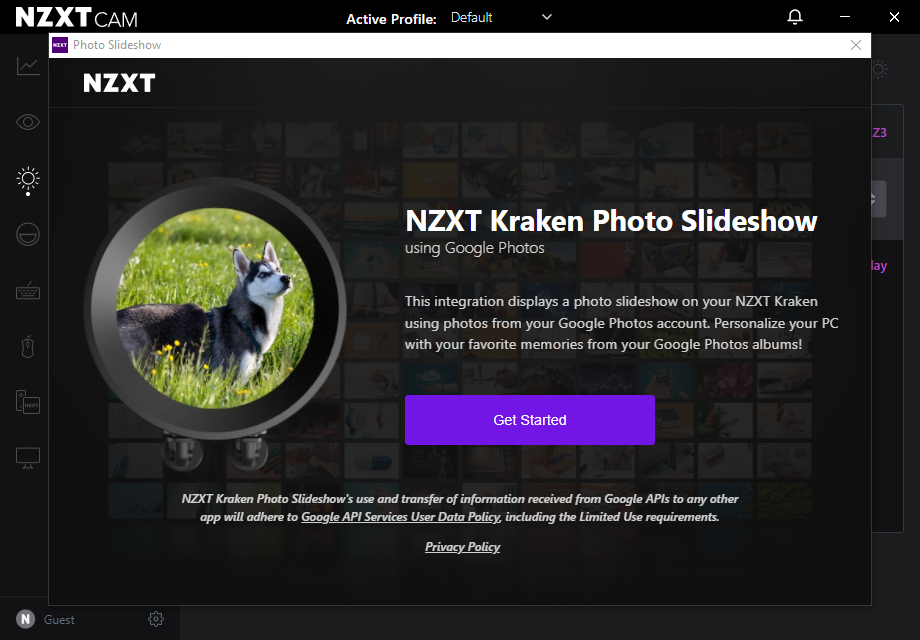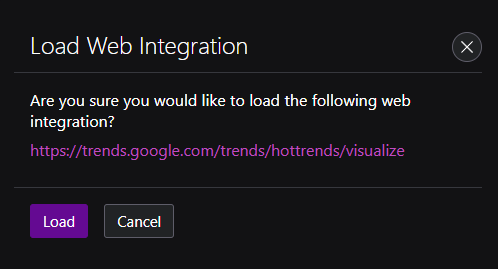Development
Introduction
Web Integration mode relies on two browsers we call Kraken Browser and Configuration Browser. Kraken Browser will render the content and send it to your NZXT Kraken device and Configuration Browser will be the entrypoint for the user of your application to change any options or interaction you provide.
The browsers share common session data which means state can be fully controlled by the web integration with the supplied URL.


Configuration Browser
In this browser, users may authenticate with your service or adjust settings on how and which content should be displayed on the Kraken Browser. Between these browsers, the same session data is inherited and shared as they both have the same origin. This means that any changes made to session data in one renderer process will be reflected in the other renderer process as well. This browser is not strictly necessary if your web integration does not require any setup.
Kraken Browser
This hidden browser is created by CAM when enabling Web Integration Mode. The Kraken Browser is based on the URL of the application with the addition of the query parameter ?kraken=1 supplied by CAM. This query parameter differentiates the Kraken Browser and the Configuration Browser and should be used by your application to determine what content should be displayed.
const searchParams = new URLSearchParams(window.location.search);
const kraken = searchParams.get("kraken");
// "1"
Window Attributes
The parameters width, height, shape, and targetFps are supplied via NZXT CAM to the window object which correspond to the device that is being used. With these parameters you can determine the resolution, shape, and target fps to tailor your application for different NZXT Kraken devices to make sure your application always works as intended.
window.nzxt.v1.height; // 640
Cookies (deprecated)
In addition to the query parameter supplied by Kraken Browser, CAM will also inject a cookie called viewstate into session. This cookie contains the resolution of the current NZXT Kraken device.
const viewstate = getCookie("viewstate");
// "640"
Communication
Web Integration mode does not track navigations. If the user navigates to a different url or path, the Kraken Browser will not update.
Communication between Kraken Browser and the Configuration browser has to be through session. The easiest way to communication session data is with the following APIs (Note: Only browser APIs that exist on Chromium are supported).
const kraken = window.location.search.includes("kraken=1");
if (kraken) {
// On Kraken Browser
window.addEventListener("storage", (event) => {
if (event.key === "greeting") {
console.log(event.newValue);
}
});
} else {
// On Configration Browser
window.localStorage.setItem("greeting", "hello from kraken");
}
// Kraken and Configuration Browsers
In snippet above, you can see that we are differentiating between the Kraken Browser and the Configuration Browser using the query parameter kraken. If this query parameter is present, we are on the Kraken Browser. Otherwise, we are on the Configuration Browser.
On the Kraken Browser, we are setting a listener on window to listen to any changes to the greeting key in local storage. When the Configuration Browser sets the greeting key, the Kraken Browser will log the value.
On the Configuration Browser, we are setting the greeting key in local storage.
Monitoring Data
Note: Available in CAM 4.50.0 or greater
window.nzxt = {
v1: {
onMonitoringDataUpdate: (data) => {
const { cpus, gpus, ram, kraken } = data;
}
}
};
If CAM detects that you are using the onMonitoringDataUpdate function on window, it will begin sending monitoring data to your application. This data is sent every second and contains data related to your Cpus, Gpus, and Ram.
Data Types
For the full details see our github repo.
Download @nzxt/web-integrations-types from npm to use the full monitoring types.
Sharing Web Integrations
Upon CAM's first load, a custom link protocol nzxt-cam:// is registered to the system.
For users of NZXT CAM Beta, the protocol is nzxt-cam-beta://.
The protocol, similar to http:// or https://, is designed to perform actions within CAM.
When navigating to one of this protocol inside of a web browser, CAM will be prompted to perform actions, such as loading web integrations.
Creating Shareable Links
Construct the url with your chosen protocol nzxt-cam:// or nzxt-cam-beta:// and action/load-web-integration?url=
Append the Web Integration url to the end (example: nzxt-cam://action/load-web-integration?url=https://trends.google.com/trends/hottrends/visualize)
Usage
Click or paste the link inside of a web browser
Click the Open NZXT CAM button prompted in the web browser
NZXT CAM will open and prompt the user to load the web integration
Redirect
If the protocol is not recognized as a hyperlink in the web browser, we provide cam-redirect.nzxt.com and cam-beta-redirect.nzxt.com to use instead of the protocol.

Let's Recap
- Configuration Browser is the entry point where user's can interact, and will not be given a query parameter.
- Kraken Browser displays on the NZXT Kraken device and is can be identified by a query parameter
krakeninjected into the url from CAM. - Both browsers share session data. Session data examples include cookies and local storage.
- CAM provides window attributes to the Kraken Browser so you can tailor your application to the device.
- CAM provides the query parameter
kraken="1"to the Kraken Browser, so views can be differentiated between the Kraken Browser and the Configuration Browser. - CAM provides the
onMonitoringDataUpdatefunction on window so you can receive monitoring data from CAM.
Next Steps
Look at our Web Integration Examples
If you'd like to see your Web Integration in CAM